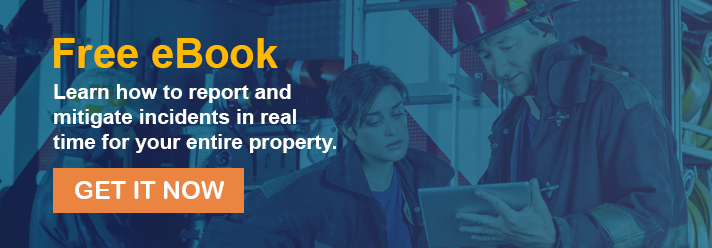You’re tasked with being the steward of safety at your property.
Ponder that responsibility.
Now, take a deep breath – because it’s a big responsibility.
The security of your customers, co-workers, boss, and every single person who enters your property lies on your shoulders.
You’re always collecting and analyzing tons of information.
To do this, to do that, you’re always faced with supplemental training, new policies, or changes in industry best practices, and then tasked to train and monitor your team.
Are they doing everything they need or could be doing?
How do you keep up with all that? How do you know what best practices should be in place for your property?
Don’t you sometimes feel like the tail of a wagging dog?
Let’s change that today.
Keep reading; we’re going to share three ways for you to be a successful steward of safety.
THE MODUS OPERANDI FOR A STEWARD OF SAFETY IS PREVENTION
It takes effort on your part. It takes effort by your team.
What’s the sum of all these efforts? It’s Prevention.
Prevention is what you’re aiming for, right?
You want to reduce your stress and enhance the customer experience.
You don’t want to increase incidents and response times that lead to more liability for your property.
That doesn't make business sense. Agree?
You want to know that when your team has an incident to handle, they are handling it correctly.
You want to be proactive.
That’s why removing the potentials for hazard and liability needs to be at the center of your operation.
3 P’S FOR SAFE AND SECURE EVENTS
Rather than simply brushing the surface of what prevention is, we’d like to hit it on the nose and give you some quick takeaway.
After you read this article, put them into action.
The P’s are a formula, and the sum (and final P) is Prevention.
Prevention is the secret to being a steward of safety. Voila!
Here’s the formula: Proactivity + Protocols = Prevention.
This method leads to safe and secure events.
It’s also quantifiable arithmetic, and we can’t argue with that, can we?
BEING EFFECTIVE IS A PROACTIVE CHOICE
Proactive leadership means acting in anticipation of future problems, needs, or changes to your operation.
Create a high-performing operation inclusive of communication methods and protocols your team will use to provide your customers with a memorable experience.
Now, show your team what it is to be a steward of safety and why it’s important to be proactive.
Your leadership and training provide your staff with the ability to see and fully understand potential hazards.
More importantly, they can execute efficiently to mitigate incidents when they occur.
It’s next-level security.
5 PROTOCOLS YOU CAN USE TODAY
Need some tips or don’t know what to watch out for – here’s what you’re looking for:
- The process starts before customers even enter the property. Identify potential hazards associated with your property or venue. Do you have broken cup holders? Are stairwells or concourses damaged? Make sure your seats and all furniture are up to par. You don’t need anyone finding the needle in the haystack – ouch!
- Locate wet spills or puddles to be handled immediately. For those of you running events where it can be quite chilly at times – be on the lookout for ice! No more slipping and falling allowed on your watch.
- It’s go-time once customers arrive. Make your presence known. It’s imperative they know your team is proactive, available, and able to respond at a moment’s notice. This practice will give you and your team control if the crowd shifts to a new location. (For sports events, an example would be when customers move from tailgating into the stadium for the game.)
- Train your staff to approach potential unruly fans (i.e., sports fans with opposing team jerseys). Direct your employees to introduce themselves. Tell customers they are available if they need assistance. (Staff can focus their attention on your text messaging software signage if your venue utilizes such a system.) A protocol such as this will deter potential unruly customers by making your presence well known.
- Identify potential hazard locations (or Hot Spots) and deploy your Incident Response Team or Hot Team to these sites. (Hint: using analytics will provide you with the data and insight you need to identify these areas.)
Wait.
There’s more.
Analytics!
There’s nothing greater or stronger than seeing hard facts.
Do you know what’s going on during your events?
This knowledge is how you’ll know your proactive efforts are coming together.
Track and use your analytics to see how effective the team is.
Track response times and the number of incidents occurring during all events.
Use analytics to drill with your team the likeliness of wet spills in specific locations.
Measure and measure again.
It’s purposeful prevention in effect.
YOU DIDN'T FOLLOW PROTOCOL
It’s like we said.
Being proactive starts with you but is accessible on all levels.
Initiate the movement, now!
Develop the protocols and let the prevention begin.
Training is the foundation of your ‘stewardship.’
Educate your staff of all the potential hazards to enhance their awareness of hot spots and triggers for hazards or incidents that may surface during events.
Now they can be proactive!
Have them report incidents and how they’re handled by an incident management system.
That way, they’re accountable and measurable. But, don’t skip that step or stop there.
You've developed protocols for staff to identify, handle and mitigate incidents. Now show them the ropes!
Walkthrough the scenarios.
Tabletop exercises get the brain working, and your team motivated.
Tabletop exercises create an active training environment with benefits galore.
We've counted ten ourselves.
OVER TO YOU
We've given you the 'Three P's.' Proactively manage your teams and event, establish protocols, and prevent potential hazards from occurring.
Proactive management and purposeful protocols result in prevention that leads to safe events, happy customers who will return for your next event, and a realized reduction in your liability.
So, how will you integrate the three P's in your operation?
Editor's note: This post was originally published in July 2014 and has been updated for comprehensiveness and freshness.




